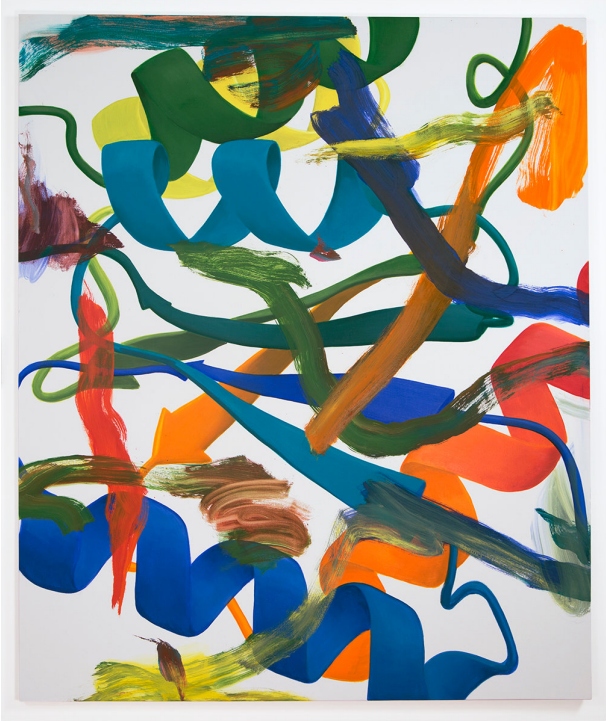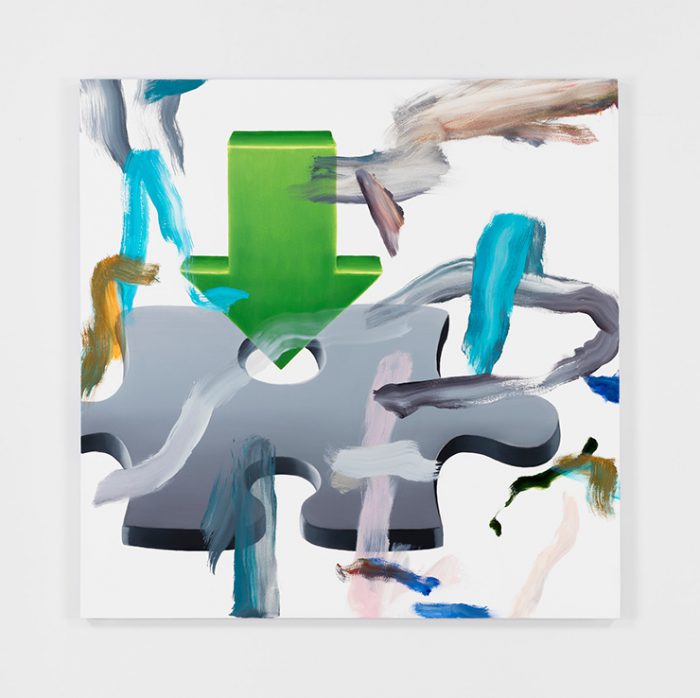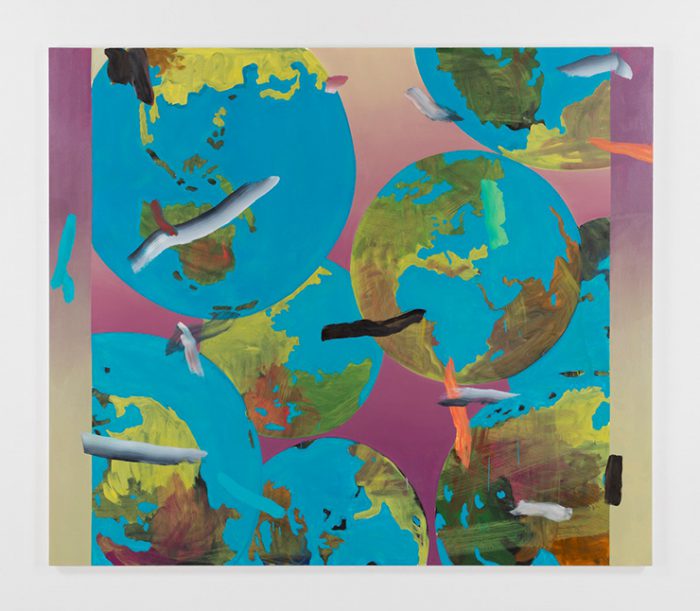Gregory Edwards’ anonymous-looking Queens studio is a glimpse into the 34-year-old’s process. Three large-scale canvases on adjacent walls make unexpected (if strangely harmonious) bedfellows. On one, a floor to ceiling gradient of a meticulously painted blue ombré suggesting an idealized sky seems hopeful and eager for the artist to make his mark. On another are round contiguous globes depicting our planet, the borders within rimmed by complementary colors which meld into sullied brown and ominous landmasses. The third is a colorful cascade of ribbons—ribbon diagrams of protein, to be exact—which exuberantly dance across the canvas.
 Edwards’ Protein Painting 5, 2015. Courtesy of 47 Canal.
Edwards’ Protein Painting 5, 2015. Courtesy of 47 Canal.
“I don’t know what these paintings will be in the end; whatever I can formally find to make it interesting, a subject matter comes out of it,” he says. Edwards, who is represented by 47 Canal, where his work will be shown at Art Basel, is starting to prepare for a solo exhibition in February. He is not preoccupied, however, with the theme of his impending shows but rather in exploring the process of approach and form and then finding out what binds them subjectively.
For Edwards, it is the space in between the representational and the abstract where the discovery lies. “With the globes, I didn’t set out to make a commentary on global warming or the Anthropocene or whatever, but that’s usually how I come to the ideas. I find some formal connection. I can’t just give into being… It is a process to really think through,” he says. “That’s the thing about combining abstraction and imagery, they both take one another into each other’s realm.
 Edwards’ Puzzle Piece, 2016. Courtesy of 47 Canal.
Edwards’ Puzzle Piece, 2016. Courtesy of 47 Canal.
You start to look at the Earth as more abstract and the drips more as material instead of just paint.” This interplay is one of the binding characteristics of the oeuvre of the young artist. In his 47 Canal solo show last year, “Steady Work,” Edwards explored self-help culture, painting words like “attraction” and “communication” and pairing them with gestural brush strokes and vivid stripes. “It was fascinating to investigate that culture.
Having to paint those words requires concentration; a lot of self-help ideas are about focus and the law of attraction. No matter how much doubt I have, if I am sitting there all day trying to paint the word “attraction,” what kind of effect will that have?” Edwards says, eager to dispute that he was mocking the social trend. “Sure there was cynicism, there has to be tension. That’s what gives it its power in a way.” Edwards, who graduated from the School of Visual Arts and attended the prestigious Städelschule in Frankfurt, finds inspiration in artists working in different mediums. “I like to look at art that isn’t painting, that does things for me,” he says.
 Edwards’ World Painting 2, 2016. Courtesy of 47 Canal.
Edwards’ World Painting 2, 2016. Courtesy of 47 Canal.
“Isa Genzken offers a freedom I can only distantly strive for. I often look to the visceral or even messy.” Wolfgang Tillmans, Michel Majerus and Edwards’ own wife, sculptor Alisa Baremboym (with whom he shared a joint show in 2014), are cross-disciplinary inspirations to his work.For now though, Edwards is busy deciphering his latest fascination with ribbon diagrams. “I don’t know whether it’s an image or an object or a kind of language or maybe it’s a form of all three,” he says. “I just like to find that space. It’s something that painting can distinctly accommodate. You’re able to find the in between.”










 in your life?
in your life?

